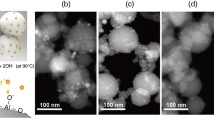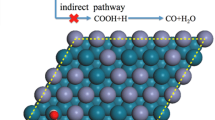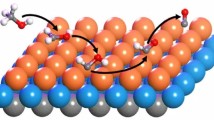Abstract
The electro-oxidation of dimethyl ether (DME) was investigated using periodic, self-consistent density functional theory (DFT) calculations on the (111) and (100) facets of eight fcc metals: Au, Ag, Cu, Pt, Pd, Ni, Ir, and Rh. The goal of this study is to understand the experimentally observed structure sensitivity of this reaction on Pt, and to predict trends in structure sensitivity of this reaction across the other seven metals studied. The main conclusion is that the enhanced activity of Pt(100) originates from more facile C–O bond breaking and removal of surface poisoning species, including CO and CH. When comparing C–O bond breaking energetics, we do not find a universal trend where these elementary steps are always more exergonic on the (100) facet. However, we find that, at a given potential, DME can be dehydrogenated (prior to breaking the C–O bond) to a greater extent on the (100) facet. Additionally, we find that the reaction energy for C–O bond breaking in CHxOCHy-type species becomes increasingly exergonic as the species becomes increasingly dehydrogenated. Together, the more facile dehydrogenation on the (100) facets provides more favorable routes to C–O bond activation. Though we calculate a lower onset potential on Au(100), Ag(100), Cu(100), Pt(100), and Pd(100) than their respective (111) facets, the calculated onset potential for Ni(100), Ir(100), and Rh(100) are actually higher than for their respective (111) facets. Finally, by constructing theoretical volcano plots, we conclude that Au(100), Ag(100), Cu(100), Pt(100), and Pd(100) should be more active than their respective (111) facets, while Ni(100), Rh(100), and Ir(100) will show the opposite trend.







Similar content being viewed by others
References
Semelsberger TA, Borup RL, Greene HL (2006) Dimethyl ether (DME) as an alternative fuel. J Power Sources 156(2):497–511
Floudas CA, Elia JA, Baliban RC (2012) Hybrid and single feedstock energy processes for liquid transportation fuels: a critical review. Comput Chem Eng 41:24–51
Serov A, Kwak C (2009) Progress in development of direct dimethyl ether fuel cells. Appl Catal B 91(1–2):1–10
Demirci UB (2007) Direct liquid-feed fuel cells: thermodynamic and environmental concerns. J Power Sources 169(2):239–246
Yoo JH, Choi HG, Chung CH, Cho SM (2006) Fuel cells using dimethyl ether. J Power Sources 163(1):103–106
Yu RH, Choi HG, Cho SM (2005) Performance of direct dimethyl ether fuel cells at low temperature. Electrochem Commun 7(12):1385–1388
Kerangueven G, Coutanceau C, Sibert E, Leger JM, Lamy C (2006) Methoxy methane (dimethyl ether) as an alternative fuel for direct fuel cells. J Power Sources 157(1):318–324
Kerangueven G, Coutanceau C, Sibert E, Hahn F, Leger JM, Lamy C (2006) Mechanism of di(methyl)ether (DME) electrooxidation at platinum electrodes in acid medium. J Appl Electrochem 36(4):441–448
Heinzel A, Barragan VM (1999) A review of the state-of-the-art of the methanol crossover in direct methanol fuel cells. J Power Sources 84(1):70–74
Wasmus S, Kuver A (1999) Methanol oxidation and direct methanol fuel cells: a selective review. J Electroanal Chem 461(1–2):14–31
Mizutani I, Liu Y, Mitsushima S, Ota KI, Kamiya N (2006) Anode reaction mechanism and crossover in direct dimethyl ether fuel cell. J Power Sources 156(2):183–189
Muller JT, Urban PM, Holderich WF, Colbow KM, Zhang J, Wilkinson DP (2000) Electro-oxidation of dimethyl ether in a polymer-electrolyte-membrane fuel cell. J Electrochem Soc 147(11):4058–4060
Liu Y, Mitsushima S, Ota K, Kamiya N (2006) Electro-oxidation of dimethyl ether on Pt/C and PtMe/C catalysts in sulfuric acid. Electrochim Acta 51(28):6503–6509
Lu LL, Yin GP, Tong YJ, Zhang Y, Gao YZ, Osawa M, Ye S (2008) Electrochemical behaviors of dimethyl ether on platinum single crystal electrodes. Part I: Pt(111). J Electroanal Chem 619:143–151
Lu LL, Yin GP, Tong YJ, Zhang Y, Gao YZ, Osawa M, Ye S (2010) Electrochemical behaviors of dimethyl ether on platinum single crystal electrodes. Part II: Pt(100). J Electroanal Chem 642(1):82–91
Tong Y, Lu L, Zhang Y, Gao Y, Yin G, Osawa M, Ye S (2007) Surface structure dependent electro-oxidation of dimethyl ether on platinum single-crystal electrodes. J Phys Chem C 111(51):18836–18838
Koper MTM (2011) Structure sensitivity and nanoscale effects in electrocatalysis. Nanoscale 3(5):2054–2073
Lu LL, Yin GP, Wang ZB, Gao YZ (2009) Electro-oxidation of dimethyl ether on platinum nanocubes with preferential 100 surfaces. Electrochem Commun 11(8):1596–1598
Herron JA, Ferrin P, Mavrikakis M (2014) First-principles mechanistic analysis of dimethyl ether electro-oxidation on monometallic single-crystal surfaces. J Phys Chem C 118(42):24199–24211
Hammer B, Hansen LB, Nørskov JK (1999) Improved adsorption energetics within density-functional theory using revised Perdew–Burke–Ernzerhof functionals. Phys Rev B 59(11):7413–7421
Greeley J, Nørskov JK, Mavrikakis M (2002) Electronic structure and catalysis on metal surfaces. Annu Rev Phys Chem 53:319–348
Ferrin P, Mavrikakis M (2009) Structure sensitivity of methanol electrooxidation on transition metals. J Am Chem Soc 131(40):14381–14389
Ferrin P, Nilekar AU, Greeley J, Mavrikakis M, Rossmeisl J (2008) Reactivity descriptors for direct methanol fuel cell anode catalysts. Surf Sci 602(21):3424–3431
Greeley J, Mavrikakis M (2002) A first-principles study of methanol decomposition on Pt(111). J Am Chem Soc 124(24):7193–7201
Greeley J, Mavrikakis M (2004) Competitive paths for methanol decomposition on Pt(111). J Am Chem Soc 126(12):3910–3919
CRC (2011) Handbook of chemistry and physics, 92nd edn. CRC Press, New York
Bengtsson L (1999) Dipole correction for surface supercell calculations. Phys Rev B 59(19):12301–12304
Neugebauer J, Scheffler M (1992) Adsorbate-substrate and adsorbate-adsorbate interactions of Na and K adlayers on Al(111). Phys Rev B 46(24):16067–16080
Vanderbilt D (1990) Soft self-consistent pseudopotentials in a generalized eigenvalue formalism. Phys Rev B 41(11):7892–7895
Chadi DJ, Cohen ML (1973) Special points in Brillouin zone. Phys Rev B 8(12):5747–5753
Monkhorst HJ, Pack JD (1976) Special points for Brillouin-zone integrations. Phys Rev B 13(12):5188–5192
Perdew JP, Chevary JA, Vosko SH, Jackson KA, Pederson MR, Singh DJ, Fiolhais C (1992) Atoms, molecules, solids, and surfaces—applications of the generalized gradient approximation for exchange and correlation. Phys Rev B 46(11):6671–6687
Greeley J, Mavrikakis M (2003) A first-principles study of surface and subsurface H on and in Ni(111): diffusional properties and coverage-dependent behavior. Surf Sci 540(2–3):215–229
Rossmeisl J, Qu ZW, Zhu H, Kroes GJ, Nørskov JK (2007) Electrolysis of water on oxide surfaces. J Electroanal Chem 607(1–2):83–89
Rossmeisl J, Logadottir A, Nørskov JK (2005) Electrolysis of water on (oxidized) metal surfaces. Chem Phys 319(1–3):178–184
Karlberg GS, Rossmeisl J, Nørskov JK (2007) Estimations of electric field effects on the oxygen reduction reaction based on the density functional theory. Phys Chem Chem Phys 9(37):5158–5161
Nørskov JK, Rossmeisl J, Logadottir A, Lindqvist L, Kitchin JR, Bligaard T, Jonsson H (2004) Origin of the overpotential for oxygen reduction at a fuel-cell cathode. J Phys Chem B 108(46):17886–17892
Herron JA, Ferrin P, Mavrikakis M (2015) Electrocatalytic oxidation of ammonia on transition-metal surfaces: a first-principles study. J Phys Chem C 119(26):14692–14701
Logadottir A, Rod TH, Nørskov JK, Hammer B, Dahl S, Jacobsen CJH (2001) The Bronsted–Evans–Polanyi relation and the volcano plot for ammonia synthesis over transition metal catalysts. J Catal 197(2):229–231
Nørskov JK, Bligaard T, Logadottir A, Bahn S, Hansen LB, Bollinger M, Bengaard H, Hammer B, Sljivancanin Z, Mavrikakis M, Xu Y, Dahl S, Jacobsen CJH (2002) Universality in heterogeneous catalysis. J Catal 209(2):275–278
Ojeda M, Nabar R, Nilekar AU, Ishikawa A, Mavrikakis M, Iglesia E (2010) CO activation pathways and the mechanism of Fischer–Tropsch synthesis. J Catal 272(2):287–297
Grabow LC, Hvolbaek B, Nørskov JK (2010) Understanding trends in catalytic activity: the effect of adsorbate–adsorbate interactions for CO oxidation over transition metals. Top Catal 53(5–6):298–310
Miller SD, Inoglu N, Kitchin JR (2011) Configurational correlations in the coverage dependent adsorption energies of oxygen atoms on late transition metal fcc(111) surfaces. J Chem Phys 134(10):104709
Wu C, Schmidt DJ, Wolverton C, Schneider WF (2012) Accurate coverage-dependence incorporated into first-principles kinetic models: catalytic NO oxidation on Pt (111). J Catal 286:88–94
Getman RB, Xu Y, Schneider WF (2008) Thermodynamics of environment-dependent oxygen chemisorption on Pt(111). J Phys Chem C 112(26):9559–9572
Desai S, Neurock M (2003) A first principles analysis of CO oxidation over Pt and Pt66.7%Ru33.3% (111) surfaces. Electrochim Acta 48(25–26):3759–3773
Koper MTM (2005) Combining experiment and theory for understanding electrocatalysis. J Electroanal Chem 574(2):375–386
Lew WD, Crowe MC, Karp E, Campbell CT (2011) Energy of molecularly adsorbed water on clean Pt(111) and Pt(111) with coadsorbed oxygen by calorimetry. J Phys Chem C 115(18):9164–9170
Ogasawara H, Brena B, Nordlund D, Nyberg M, Pelmenschikov A, Pettersson LGM, Nilsson A (2002) Structure and bonding of water on Pt(111). Phys Rev Lett 89(27):276102
Rossmeisl J, Greeley J, Karlberg GS (2008) Electrocatalysis and catalyst screening from density functional theory calculations. In: Koper MTM (ed) Fuel cell catalysis: a surface science approach. Wiley, Hoboken
Mistry H, Reske R, Zeng ZH, Zhao ZJ, Greeley J, Strasser P, Cuenya BR (2014) Exceptional size-dependent activity enhancement in the electroreduction of CO2 over Au nanoparticles. J Am Chem Soc 136(47):16473–16476
Karamad M, Tripkovic V, Rossmeisl J (2014) Intermetallic alloys as CO electroreduction catalysts—role of isolated active sites. ACS Catal 4(7):2268–2273
Van Santen RA (2009) Complementary structure sensitive and insensitive catalytic relationships. Acc Chem Res 42(1):57–66
Ciobica IM, van Santen RA (2003) Carbon monoxide dissociation on planar and stepped Ru(0001) surfaces. J Phys Chem B 107(16):3808–3812
Andersson MP, Abild-Pedersen E, Remediakis IN, Bligaard T, Jones G, Engbwk J, Lytken O, Horch S, Nielsen JH, Sehested J, Rostrup-Nielsen JR, Nørskov JK, Chorkendorff I (2008) Structure sensitivity of the methanation reaction: H2-induced CO dissociation on nickel surfaces. J Catal 255(1):6–19
Dahl S, Logadottir A, Egeberg RC, Larsen JH, Chorkendorff I, Tornqvist E, Nørskov JK (1999) Role of steps in N2 activation on Ru(0001). Phys Rev Lett 83(9):1814–1817
Spencer ND, Schoonmaker RC, Somorjai GA (1982) Iron single-crystals as ammonia-synthesis catalysts—effect of surface-structure on catalyst activity. J Catal 74(1):129–135
Loffreda D, Simon D, Sautet P (2003) Structure sensitivity for NO dissociation on palladium and rhodium surfaces. J Catal 213(2):211–225
Ge Q, Neurock M (2004) Structure dependence of NO adsorption and dissociation on platinum surfaces. J Am Chem Soc 126(5):1551–1559
Liu ZP, Hu P (2003) General rules for predicting where a catalytic reaction should occur on metal surfaces: a density functional theory study of C-H and C–O bond breaking/making on flat, stepped, and kinked metal surfaces. J Am Chem Soc 125(7):1958–1967
Koper MTM (2011) Thermodynamic theory of multi-electron transfer reactions: implications for electrocatalysis. J Electroanal Chem 660(2):254–260
Li HJ, Calle-Vallejo F, Kolb MJ, Kwon Y, Li YD, Koper MTM (2013) Why (100) terraces break and make bonds: oxidation of dimethyl ether on platinum single-crystal electrodes. J Am Chem Soc 135(38):14329–14338
Li HJ, Li YD, Koper MTM, Calle-Vallejo F (2014) Bond-making and breaking between carbon, nitrogen, and oxygen in electrocatalysis. J Am Chem Soc 136(44):15694–15701
Lebedeva NP, Rodes A, Feliu JM, Koper MTM, van Santen RA (2002) Role of crystalline defects in electrocatalysis: CO adsorption and oxidation on stepped platinum electrodes as studied by in situ infrared spectroscopy. J Phys Chem B 106(38):9863–9872
Abild-Pedersen F, Greeley J, Studt F, Rossmeisl J, Munter TR, Moses PG, Skulason E, Bligaard T, Nørskov JK (2007) Scaling properties of adsorption energies for hydrogen-containing molecules on transition-metal surfaces. Phys Rev Lett 99(1):016105
Acknowledgments
Prof. Vayenas has inspired many colleagues in the field of electrocatalysis, including these authors. We wish him the best on the occasion of his 65th birthday. This work was supported by DOE-BES, Office of Chemical Sciences. JAH thanks Air Products & Chemicals, Inc. for partial support through a graduate fellowship. Computational work was performed in part using supercomputing resources at the following institutions: EMSL, a National scientific user facility at Pacific Northwest National Laboratory (PNNL); the Center for Nanoscale Materials at Argonne National Laboratory (ANL); and the National Energy Research Scientific Computing Center (NERSC). EMSL is sponsored by the Department of Energy’s Office of Biological and Environmental Research located at PNNL. CNM, and NERSC are supported by the U.S. Department of Energy, Office of Science, under contracts DE-AC02-06CH11357, and DE-AC02-05CH11231, respectively.
Author information
Authors and Affiliations
Corresponding author
Electronic supplementary material
Below is the link to the electronic supplementary material.
Rights and permissions
About this article
Cite this article
Herron, J.A., Ferrin, P. & Mavrikakis, M. On the Structure Sensitivity of Dimethyl Ether Electro-oxidation on Eight FCC Metals: A First-Principles Study. Top Catal 58, 1159–1173 (2015). https://doi.org/10.1007/s11244-015-0495-5
Published:
Issue Date:
DOI: https://doi.org/10.1007/s11244-015-0495-5




